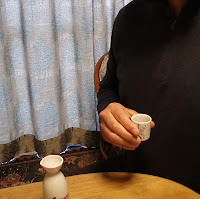Short time ago, I attended an event to learn about sake and table manners for Japanese cuisine held in Bunkyo Ward, Tokyo.
In the event, how sake is made, what types of sake there are, as well as table manners for drinking sake and eating Japanese cuisine are explained.
The lesson about sake was nothing new for me. However, I think the lesson of table manners we should observe when drinking sake and eating Japanese foods was useful for me, and I would like to share what I learned with my blog readers.
Manners at a sake drinking party
Toast
Do not contact your sake cup directly with others to prevent the cups to be damaged. Instead, wrap your fingers around the cup so that your fingers touch others.
Use both hands
Hold the cup with your right hand and support the bottom with your left hand when raising a cup for a toast or when someone superior pouring sake for you.
Do not leave your cup on the table when someone is pouring sake for you.
(Use both hands)

At least a sip
When your cup is not empty but someone is about to pour sake for you, you must drink at least a sip of the sake in your cup before she/he pours sake.
Bring your cup toward you
When drinking sake, do not bring your mouth to the cup, bring your cup toward you place it in front of your chest once and then raise your cup to your mouth. Actually, this way of drinking straightens your back and you will look elegant.
(Left: bad example, Right: Good example)


Mouse tail, horse tail, mouse tail?
When pouring sake, hold the sake bottle with your right hand, and keep the back of your hand turned up, while supporting the bottle with the left hand. Holding the sake bottle on your right hand palm and placing the palm in the face-up position is a "backhanded manner."
Pour sake thinly like a mouse tail at the beginning, then, thickly like a horse tail, and again, thinly like a mouse tail at the end.
(Left: bad example, Right: Good example)


(To be continued.)
Today's Sake
Kamotsuru Junmaishu (Kamotsuru Sake Brewing Company)
This sake is quite dry but has a good taste of rice.
Seimaibuai: 69%
Alcohol: 14 - 15%
Sake meter value: (+)4
































